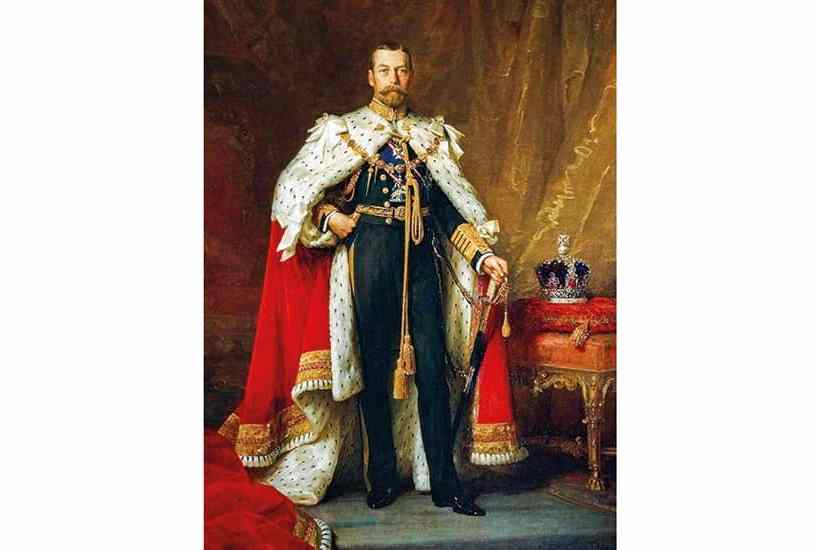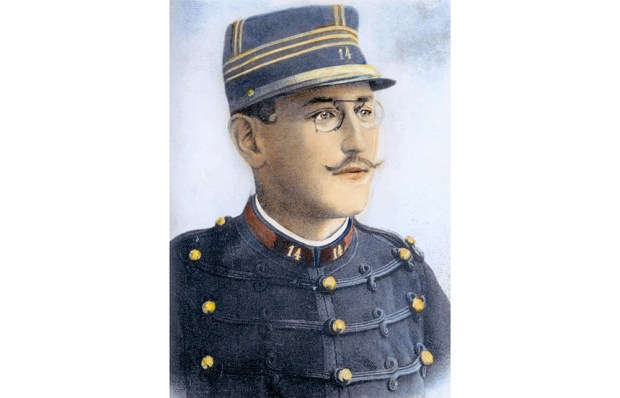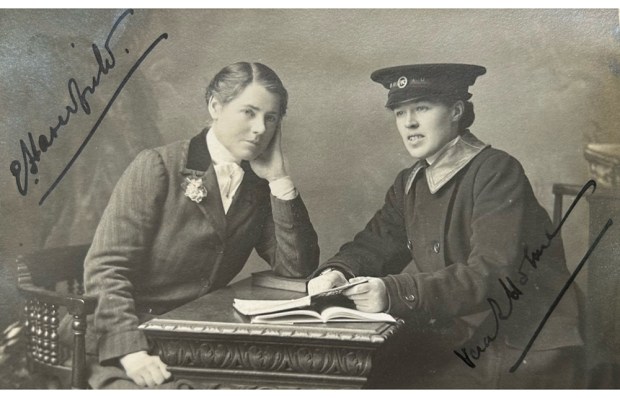‘Victorian’ stuck, and ‘Edwardian’ too. But ‘Georgian’, as an adjective associated with the next monarch in line, never caught on. It was already assigned, of course, but George V very strikingly didn’t embody his time in the way that his father and grandmother did. The adjective only really succeeded in one specific instance: as the name of a school of poets. The anthologies Harold Monro published between 1911 and 1922 under the title ‘Georgian Poetry’ created a lasting school of poets — like the King, well-made, efficient, reticent and given to outbursts of intense romantic emotion.
George V is not much associated with poetry; but his character is more complex than many of his contemporaries understood. He was a great lover of novels, like his grandmother, and is recorded reading Uncle Tom’s Cabin, Pendennis and, surprisingly, Lady Chatterley’s Lover, as well as the thunderous yarns of Captain Marryat and Harrison Ainsworth. Between 1933 and 1935, he read 159 books. He was, in my view, the best-dressed of any English monarch. Every photograph of him is of breathtaking, restrained elegance. He had a famously happy marriage with another gruff introvert, May of Teck, in which they apparently found it hard to convey their feelings for each other in speech. There is an enchanting 1935 photograph of Queen Mary on a garden bench with the King, her hand resting shyly on his thigh. From many hints, I find him the most mysteriously tantalising of 20th-century monarchs. One of his grandmother’s courtiers said that you could never use the expression ‘a woman like Queen Victoria’ because she was utterly unique. Much the same might be said of her grandson.
The lives of monarchs have a double aspect. The first is the individual, the passions and friendships, the flesh and blood and dreaming. The second is the constitutional peg. The best royal biographies, such as Jane Ridley’s superb previous book on Edward VII, Ben Pimlott’s penetrating life of the present Queen and Sarah Bradford’s on George VI, balance the human with the constitutional principle. It is the way the two overlap, or conflict with each other, that gives the genre its force. Queen Victoria’s passionate impulsiveness took on larger implications in her relations with Gladstone, for instance, and in her withdrawal after Albert’s death.
George V is a peculiarly interesting subject for study. There were a number of major constitutional questions during his reign which required the Crown to take action. These were mostly the consequence of immense upheavals in society. The widening of the electorate required the limitation of the powers of the House of Lords in the 1911 Parliament Bill. A recently unearthed memorandum by the Archbishop of Canterbury shows how active the King was in supporting this. Much later, there was the creation of a coalition government in 1931. This was actually first suggested by the King. George came to an understanding with the new socialist politicians, a surprising amount of this expressed through his personal decisions on what might be worn by them at court. (It’s amazing how much of the significance of what happened to George might be expressed through descriptions of men’s trousers.)
Just why all this mattered to the monarchy is easily revealed by what was happening to George’s peers. Five months after George came to the throne, the Portuguese monarchy was overthrown. During the next 25 years, the monarchs of Germany, Austria-Hungary, Russia, Greece, the Balkans and Bulgaria were removed, sometimes violently. From the point of view of the institution, the obligation was on George to act in order to survive. He was much more strongly opposed to offering his cousin Tsar Nicholas asylum in Britain in 1917 than his government was, horrible as the consequences for the Russian royal family were to be.
These obligations fell on a person whose suitability was not immediately obvious. The outline of George’s story is familiar — the second son of Bertie and his adoring, beautiful, spiteful wife Alexandra. He was not the heir, but the spare, originally intended for a career in the navy. His elder brother, the Duke of Clarence and Avondale, a likeable but mentally negligible sprig, died on the verge of marrying — an event regarded as a catastrophe at the time but later as something of a blessing. His fiancée, Princess May of Teck, a poor relation, was transferred to the next-in-line, George. They were the making of each other. French wits referred to her as the soutien-Georges, punning on the word for corset, and she certainly put the backbone in him, as his position made her overcome her natural shyness. There has never been the slightest whisper of infidelity or its temptation on either part. George had seen enough of his father’s mistresses.
In 1910 the new King and Queen struck most people as comically drab after the louche splendour of Edward VII’s court. At family dinners, the King would begin cosily by saying: ‘We won’t talk, will we?’ One of Max Beerbohm’s funniest poems from these early years is ‘Ballade Tragique, à Double Refrain’, part of which goes:
HE: …Last evening
I found him with a rural dean
Talking of district visiting…
The King is duller than the Queen.
SHE: At any rate he doesn’t sew!
You don’t see him embellishing
Yard after yard of calico…
The Queen is duller than the King.
It is fair to say the couple went on puzzling smart society to the end, personifying a kind of introverted splendour. Other biographers have described the formality of the court in the 1920s as an enchanted, enclosed castle, with wildness breaking out beyond the walls. But George V’s success ensured the survival of the institution, even though things came close to falling apart after his death.
Both George and Mary have inspired great biographies in the past, including James Pope-Hennessy’s life of the queen. Ridley has written a magnificent new life — wonderfully funny, from its winning subtitle onwards, and full of human sympathy and understanding. One previous biographer, Harold Nicolson, was exactly the kind of worldly sophisticate who couldn’t understand George, famously remarking that for 17 years he did nothing at all but kill animals and stick in stamps. Ridley, by contrast, is patient, attentive and interested. She has made full use of new material that has emerged since Kenneth Rose’s 1980s biography and has capitalised, to exhilarating effect, on the recent publication of Pope-Hennessy’s research notes.
I wish conventions and proprieties had permitted her to interview perhaps the only living person with intimate recollections of George, HM the Queen. But failing that, she has produced an evocative and touching portrait of a surprisingly impressive man. There are a number of funny stories about George V, but one I like very much is of him and the Tate gallery being inflicted on each other. At one point he called out: ‘May, here’s something that’ll make you laugh.’ It was a Cézanne. What I like is the tender detail of his looking out, as monarchs rarely do, for other people’s amusement.
Got something to add? Join the discussion and comment below.
Get 10 issues for just $10
Subscribe to The Spectator Australia today for the next 10 magazine issues, plus full online access, for just $10.
You might disagree with half of it, but you’ll enjoy reading all of it. Try your first month for free, then just $2 a week for the remainder of your first year.














Comments
Don't miss out
Join the conversation with other Spectator Australia readers. Subscribe to leave a comment.
SUBSCRIBEAlready a subscriber? Log in